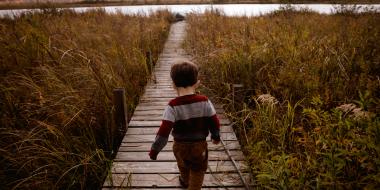Most of us approach our parenting motivated by the desire to provide better opportunities for our children than what we may have had in our own childhood. When it comes to opportunities to forge a meaningful connection to the natural environment, the odds do not favour our kids. Fortunately, there is a wealth of opportunity to access nature, even when living in the city.
Nature deficits in urban areas
Canada’s population is growing at a rapid pace for the industrialized world. Now, close to 80 percent of Canadians live in towns and cities. The Greater Toronto area is the fastest growing metropolitan area in North America. Like many environmentalists, I have watched the shape of urban development in Southern Ontario with concern.
Like many regions across North America, Southern Ontario has seen many of its farms, forests and wetlands disappear at an alarming rate while its landscape becomes a car-centric sprawling suburbia. Twenty years ago, we fought to protect the nature in our backyards from becoming the next subdivision. Now we have a much bigger fight on our hands — the fight to ensure nature plays a role in the lives of our children.
Suburban growth is harmful to our environment and our health. On average, families and children in suburbs walk and bike less. These auto-dependent, fragmented communities create more emissions than denser cities. Kids spend more time indoors, doing sedentary activities like watching TV and surfing the Internet. They are exposed to more pollution both inside and outside of the home. They eat more imported and processed foods than ever before.
Authors, the medical community and scientists are pointing to the impact this trend is having on our children’s health. Depression, ADHD, and Type II diabetes are increasing. Obesity rates in Canadian children have almost tripled in the last 25 years.
All of this has been coined as “nature deficit-disorder” by author Richard Louv, and he writes in his book Last Child in the Woods that today’s children will be the “first generation to be raised without a meaningful contact with the natural world.”
He also points to a growing body of research that shows just how important nature, particularly unstructured play in nature, is to our children’s health and development. It has been shown that spending time in nature can nurture emotional health, creativity, and sharpen thinking skills.
Fortunately, Louv is not alone in sounding the alarm on how kids are losing out from this nature-disconnect. His book has sparked a growing movement happening from the ground up that looks to preserve green spaces, agriculture and reconnect our children with nature. And it is happening inside and outside of our cities.
Urban gardening
While farming in a city is not a new phenomenon, it has many social and economic benefits. Urban gardens, whether on rooftops, in backyards and in vacant public spaces provide opportunities for kids to get their hands dirty while growing their own veggies and herbs. Such an environment also exposes them to the birds, bees, and butterflies that call gardens their home.
One small non-profit in Toronto, Green Thumbs Growing Kids, offers food-growing and hands on environmental education programs at inner-city schools and parks in the east downtown neighbourhoods of St. James Town, Cabbagetown, Regent Park, and Moss Park.
Urban parks
Nature does not need to be a destination. Many of our city parks provide opportunities to teach children about how trees clean and cool our air, absorb pollutants, store and filter rainwater and are home to many insects, birds and other species.
In Vancouver, the Stanley Park Ecology Society uses the urban park to inspire people of all ages and backgrounds to learn about ecology in Stanley Park and beyond. The small non-profit provides groups and individuals with nature walks and a drop-in nature centre. The group also runs one of the most widely respected cohabiting with coyote programs in North America.
One of the most exciting developments is Canada’s first urban national park. Despite being in the heart of one of the densest urban areas in North America, the Rouge Valley Conservation Centre is a surprisingly intact area of forests, fields, and waterways that meanders from the Oak Ridges Moraine in Markham to the shoreline of Lake Ontario in Scarborough. Rouge Park is the first national park that is accessible by public transit for millions of city dwellers.
Greenbelts
Governments play an important role in how our communities grow, whether that be growing them up instead of out, encouraging more vibrant and walkable cities, or encouraging smart planning to protect spaces where growth should be avoided. Greenbelts are a sign of what can be accomplished when communities, environmentalists and governments work together towards a common goal.
Greenbelts have become an international movement to protect food lands and nature from sprawling urban areas. The 1.8 million acre Ontario Greenbelt is the world’s largest and is estimated to provide the Golden Horseshoe region with more than $2.6 billion in economic benefits each year in services like water purification and tourism.
As parents, we owe it to our kids to safeguard what nature is left in order to provide a healthy, fulfilling future for our kids and to ensure that they grow up as strong stewards of the environment, and in turn climate change problem-solvers.
Steps to take for our children, and our environment:
- Take your child to a farm to pick wild berries, veggies or fruit. Go home and make something with it together as a family.
- Grow and tend to a garden with your children.
- Eat local. Shop at a farmers’ market with your children.
- Celebrate milestones with activities that are focused on the outdoors like hiking, swimming, and playing in parks.
- Enroll your kids in extra-curricular activities that are focused on the outdoors, including camps and sports like canoeing and hiking.
- Elect candidates at the federal, provincial and municipal level who support measures to conserve green spaces.






